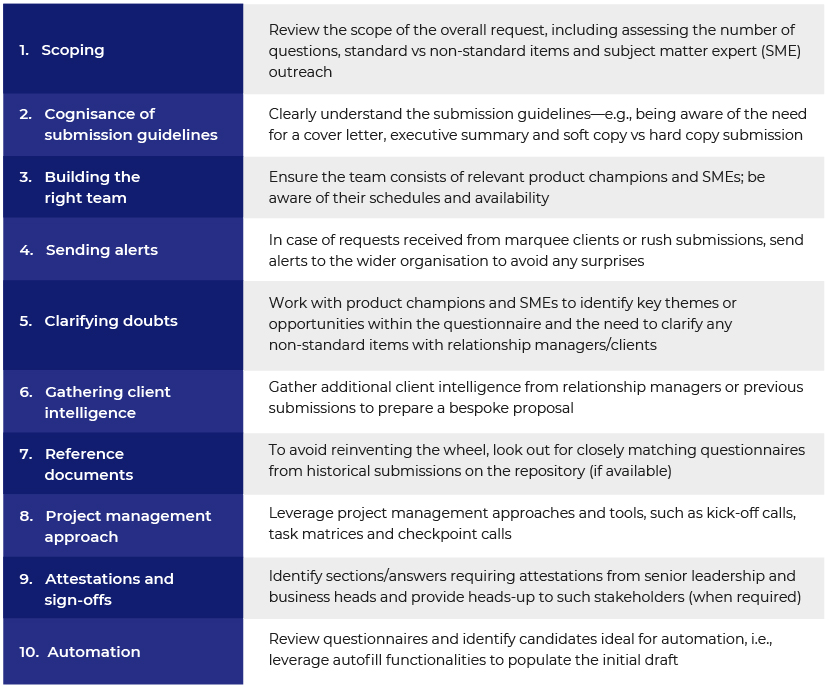Published on April 28, 2021 by Rajeev Sinha
“Give me six hours to chop down a tree, and I will spend the first four sharpening the axe.” This quote by Abraham Lincoln is perfectly suited to the craft of writing requests for proposal (RFPs) for financial services, and has lessons for the wider RFP community.
As RFP teams often operate within a fluid environment, writers are expected to prioritise either meeting client deadlines or producing bespoke proposals — the latter requires not only dedicated time and effort, but also a perfect game plan. A pertinent question that surfaces as a result is, ‘What does it take for RFP leaders (managing high-impact global RFP teams) to create the much needed time and space that can enable their writers to produce compelling bespoke proposals?
RFP process workflow – Phased approach
If we observe closely the various stages of efficient RFP process workflows developed and adopted by leading financial institutions (including asset and wealth managers, commercial banks and private equity firms), we see that the effort invested to complete an RFP is often rationed across multiple phases to ensure a focused approach through the project life cycle (e.g., initiation and planning: 20%, drafting: 40%, editing: 20%, quality control: 10%, submission: 5% and post-submission: 5%). Each phase, from planning until submission, includes action items that are mutually exclusive and collectively exhaustive and, when applied methodically, can lead to seamless execution and delivery.

Phased approach – A sense check for time allocation and efficient collaboration
A ‘phased approach’ to RFP completion offers guidance on the average time writers spend on each phase and, thus, help them better prioritise and plan work. In addition, it can enable more meaningful discussions during RFP teams’ weekly check-ins and huddles. For example, writers could use these opportunities to raise potential amber/red flags or the need for divide and conquer and relay success stories from recent submissions and lessons learnt, ensuring collaboration across the team.
Such a phased approach can also allow managers to gain insights on inefficient trends or patterns within the team through regular interactions. These can be leveraged to assess training requirements of team members and, subsequently, design bespoke training modules that help writers put their best foot forward (e.g., product and process knowledge, project management, navigating the knowledge base and people skills).
But a key question we need to ask within the community is—are RFP writers/managers really spending time on planning and preparation? If so, what constitutes the planning phase?
Planning – a prerequisite to successful RFP completion
In a phased approach, planning is regarded as a prerequisite to successful RFP completion. To stay on top of assignments, writers across leading RFP teams maintain checklists, including action items to be executed during the planning phase. A representative list of key action items that may be considered during the planning stage of an assignment is given below.

If you fail to plan, you plan to fail
What could happen if writers do not invest time in preparation and have no structure or framework to lean on? Think about a situation where a writer overlooks client-specific delivery instructions and learns about them only a few days ahead of the submission date; this could be catastrophic, as the firm may not have the bandwidth and wherewithal to deliver what the client had originally asked for—a less-than-ideal situation for any leading RFP team.
Workflow management
Planning is vital not just for writers responding to RFPs and due diligence questionnaires (DDQs), but also for managers tasked with ensuring a balanced work allocation across a team. Workflow management is often viewed as a science and art, and to build a high-impact team, it is imperative for RFP managers to put the right opportunity in the right hands.
From a scientific perspective, managers of leading RFP teams rely on workflow tools and customer relationship management software, such as Salesforce and MS Dynamics, to smartly allocate and track workflow. On the art front, managers create specialisms within teams by restructuring them by product, client segment or region. This structure is then leveraged to allocate similar or closely matching requests to the same writers, thus building a habit and leading to efficiencies and high-quality deliverables.
Conclusion
The difference between being reactive and being proactive lies in preparation. While operating within the RFP landscape, being prepared can enable RFP teams and writers to manage new business opportunities (requests for information and RFPs) and client retention efforts (DDQs) with dexterity and efficiency. This can, in turn, allow financial institutions to stick to their core value of “putting the client first”.
How Acuity Knowledge Partners can help
Would you like to know how Acuity Knowledge Partners can help you streamline your asset management RFP process? Get in touch with our experts to understand some of the emerging trends in the RFP community that can help your firm build a high-impact RFP/DDQ team.
Source:
The content above is a summary of the best practices we have witnessed while working with asset management clients over the years.
What's your view?
About the Author
Rajeev Sinha is part of the Fund Marketing Services practice at Acuity Knowledge Partners. In this role, he is primarily responsible for the management and oversight of dedicated RFP and DDQ teams that work with leading global asset management firms. Rajeev has over 10 years of sales-enablement experience. Prior to joining Acuity, he worked in various roles at J.P. Morgan, including those of a proposal writer and knowledge manager. Rajeev has also worked as an account manager for clients’ dedicated RFP teams at Genpact and Copal Amba. He started his career as a research analyst covering the private equity market at RR Donnelley. Rajeev holds..Show More
Like the way we think?
Next time we post something new, we'll send it to your inbox










